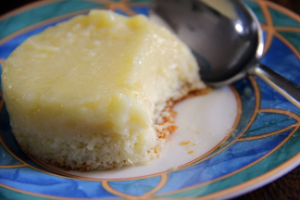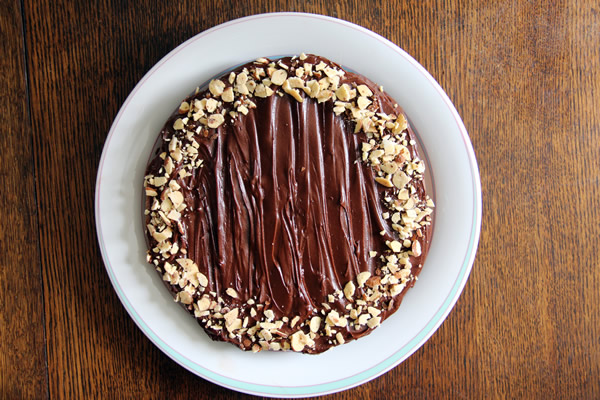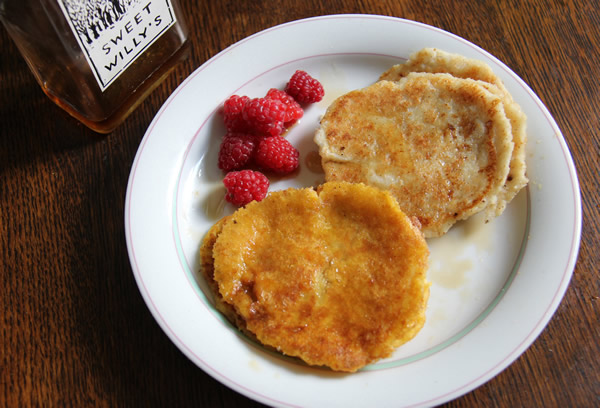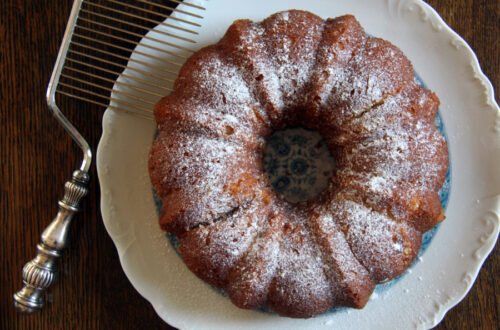You’ve heard me gush about “Ma’s Lemon Sponge Pie” for years. The tart and creamy lemon filling merges with an ethereal fluff that rises to the top as the pie bakes. So you’ve got the lemon curd on the bottom blending into an airy sponge cake that browns Maillard-style to add a hint of caramel.
Lemon sponge pie is far better than lemon meringue pie in my book, since meringue can be wet, weepy, and have the foamy texture of something expelled by an undersea creature.
A couple months ago, our friends Pam and Adam had us over for a splendid dinner of grilled delights on their rooftop patio. I brought Ma’s pie. They enjoyed it, saying that the best desserts are either lemon or chocolate (see Adam’s killer “Double Chocolate Sorbet”). Pam recently made the pie without the crust, saying she wanted to cut out that extra fat and calories, and reported delicious results. This makes sense because the lemon comes with the cakey topping, so it holds its own well without pastry.
So here’s a crustless variation which makes a lovely dessert of individual lemon sponge pudding cakes. It mixes up quickly and easily, so we get from zero to lemon sponge much faster than with a pie.
Use ramekins or clever nonstick baking cups from King Arthur, which are thin, stackable and easy to store. We serve the pudding cakes in the ramekins, or turn them out onto plates so that the lemon becomes the topping.
Since you can’t pick up and eat a slice out of your hand—the traditional way of eating Ma’s pie—lemon sponge pie lovers will have to revert to using a spoon. But it’s worth it to get that intense lemony hit—and enforced portion control.
Lemon Sponge Pudding Cakes
- 3/4 cup granulated sugar
- 1/3 cup flour
- 3 eggs, separated
- 2 tablespoons melted butter, cooled to room temperature
- 1 cup milk (skim or any fat content)
- 6 tablespoons lemon juice
- 1 teaspoon grated rind of lemon
- 1/4 teaspoon salt
- Confectioners sugar (optional) for dusting
- Preheat oven to 350°. Coat six 6-ounce ramekins (or nonstick baking cups, see above) with vegetable oil spray. In a medium bowl, whisk together sugar and flour. In another bowl, slightly beat egg yolks, then add melted butter and blend. Whisk in milk, lemon juice and grated lemon rind. Pour the lemon mixture into the dry ingredients and whisk until smooth.
- In a small bowl, beat egg whites and salt until stiff but not dry. Fold into the lemon mixture.
- Set ramekins or baking cups into a 9” x13” (or larger) baking or roasting pan. Spoon batter into cups, making sure to distribute the liquid and fluffy portions evenly. Place the pan in the oven and pour in enough hot water to reach about halfway up the sides of the cups.
- Bake about 35 minutes or until sponge is puffy, golden and slightly browned. Using tongs, transfer the ramekins to a rack and cool 10 minutes. Serve in the ramekins or run a knife around the edges and unmold onto plates. Serve warm or at room temperature, dusted with confectioners sugar if desired. Refrigerate cakes for serving within a few days.







2 Comments
Leah Greenwald
I made this recipe last night. I was a little short on lemon juice– I had about 5 T rather than 6– so I added about a teaspoon of cream of tartar, which is highly acidic, and used more grated zest. The result was terrific.
A subsequent brief Google search indicates that cream of tartar can be substituted for lemon juice in a proportion of 1:2 (meaning that cream of tartar is twice as acidic as lemon juice, so you’d need half as much of it by volume to sub for lemon juice). I haven’t done it in enough recipes to feel I can confirm that, but I did know that if you don’t want too much liquid in a mixture, cream of tartar may be a good choice to use for for some, but not all, of the acidic component. Since it doesn’t add meaningful flavor, in a delicately-flavored recipe, you increase the aromatics (in this case, grated rind) to make up for it.
Diane Brody
Hey Leah,
Woah, this is a new one! I never figured cream of tartar did much of anything. And how can it be called “cream” and have twice the acidity of lemon juice? Go figure. This is a great tip, thank you.
I often substitute sour salt for lemon juice in hummus and savory dishes, but haven’t tried it in desserts. It’s a staple of my mom’s sweet and sour cabbage (http://recipephany.com/?p=851)–do you ever use it? It also has no lemon flavor, so adding rind would be a great addition. I should keep lemon and orange rind in the freezer for such an occasion, but never get around to it.
Thank you again, Leah, for testing this recipe and giving such great eye-opening advice! I am thrilled to have this new use for cream of tartar.
xox
Diane